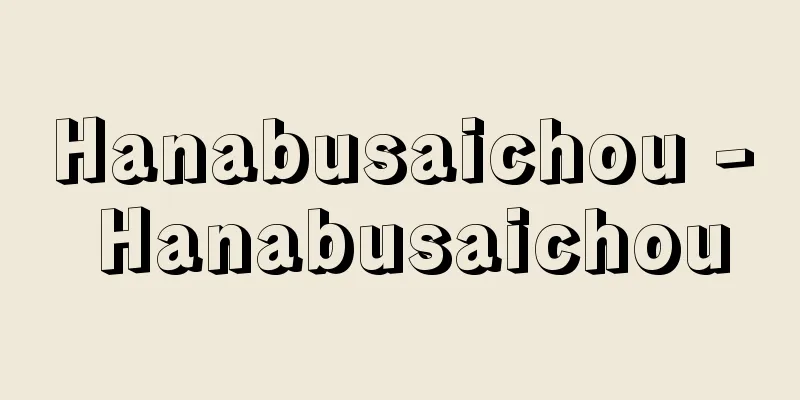Sengoku Daimyo

|
Territorial rulers who held sway all over the country during the Sengoku period. After the Onin War (1467-77), the order and authority of the Muromachi Shogunate's national governance collapsed, and the territorial control of the shugo daimyo, whose status had been maintained by the Shogunate's authority, also became unstable. Movements of overthrowing the ruling class, in which vassals who had built up power in their own areas seized real power from their lords, intensified all over the country, and the dethronement of the shogun by Kanrei Hosokawa Masamoto in 1493 (Meiō 2) marked the full-scale start of the Sengoku period. By the mid-16th century, the main Sengoku daimyo who had survived these upheavals through sheer force had emerged. [Murata Shuzo] The origins of the Sengoku daimyoThe genealogy of the Sengoku daimyo includes (1) the Imagawa of Suruga, the Takeda of Kai, the Hatakeyama of Noto, the Rokkaku of Omi, the Ouchi of Suo, the Otomo of Bungo, the Shimazu of Satsuma, and other shugo daimyo who themselves reorganized their territories in response to new trends, and (2) the Nagao (Uesugi) of Echigo, the Asakura of Echizen, the Urakami of Bizen, the Awa (3) those who rose to power from the local kokujin class, such as Matsudaira (Tokugawa) of Mikawa, Oda of Owari, Azai of Omi, Ukita of Bizen, Mori of Aki, and Chosokabe of Tosa, and (4) those of even more unusual origins, such as Hojo of Sagami and Saito of Mino, who drifted from other countries and became daimyo within a single generation. In general, Sengoku daimyo are considered to be typical of daimyo who grew up from kokujin lords, but the fact that there are surprisingly many examples of daimyo who originated as shugo daimyo indicates the weight of shugo authority within the power of daimyo. The number of Sengoku daimyo varies greatly depending on the evaluation of their content, but if you count the territorial rulers who were able to issue judgments and secure their own legal sphere, the number easily exceeds 100. As a rough guide, the Muromachi shogunate considered daimyo to be 52 people recorded as "daimyo in their own provinces" in the "Eiroku 6th Year Shoyakunin Tsuke." Of these, there were more than 30 daimyo, mainly the ones mentioned above, who established a ruling order over a wide area that could be called a province or territory, and we will list the main characteristics of these representative examples below. [Murata Shuzo] Characteristics of Sengoku daimyoA major feature that distinguishes the Sengoku daimyo from the shugo daimyo of the previous era is the establishment of transcendental territorial power that allowed the daimyo to exercise control over the territories of individual lords, as stated in the "Imagawa Kana Mokuroku" (Catalog of Kana). "The fact that the shugo envoys are not to enter occurred when, by imperial decree of the Shogunate throughout the country, the shugo positions of each province were appointed. When the shugo envoys are not to enter, it is a matter of lordship. Nowadays, everyone is expected to exercise their own capabilities and the laws of the country, and live in peace, so there should never be a time when the shugo (Sengoku daimyo) should be allowed to enter." Specific details of this included giving the daimyo exclusive authority to certify territories as chigyo (fiefs), conducting land surveys to determine the value of the land, imposing military service on the chigyo in accordance with their value, establishing courts and rules to adjudicate disputes between chigyo, creating a body of direct vassals as a military force to enforce decisions and eliminate resistance, and establishing provincial laws that made all of the above provisions public. The degree of regulation of the chigyo land varied depending on whether the original land was confirmed or new land was assigned, but the former was also changed to a provided land that could be confiscated if the vassals did not perform military service, and coupled with the progress of land surveys and the advancement of landholding, the homogenization of land was promoted, promoting the transfer of chigyo and eliminating the ties of vassals to their land. However, vassals had various statuses, such as fudai, tozama, and kokushu, depending on the origin of their vassal relationship with the daimyo, and many kokushu maintained independent territories that were not subject to the daimyo's regulations as mentioned above. Because their military service was dependent on a pact-like relationship, they were unstable and prone to rebellion, which was one of the factors that prolonged the turmoil of the Sengoku period. Therefore, the implementation of the policies of the Sengoku daimyo must be discounted, but in the main parts of their territories, they achieved considerable success with policies such as flood control and irrigation, mine development, and market and traffic control, and succeeded in seizing unprecedented productive power, which enabled them to build large-scale castles and organize musketeers to strengthen their military forces. In addition to land surveys and transfers of fiefs, it cannot be denied that the conditions for the separation of soldiers and farmers were created, as vassals increasingly concentrated in the daimyo's castle towns. For this reason, some see the Sengoku daimyo as the forerunners of modern power, but on the other hand, since land surveys did not allow them to directly grasp producers, there is also a strong view that this was the final stage of medieval power. [Murata Shuzo] "Fujiki Hisashi, 'The Social History of the Warring States Period' (1974, University of Tokyo Press)" ▽ "Nagahara Keiji, 'Japanese History 14: Warring States Turmoil' (1975, Shogakukan)" ▽ "Nagahara Keiji et al. (eds.), 'The Warring States Period' (1978, Yoshikawa Kobunkan) " ▽ "Arimitu Tomogaku (ed.), 'Warring States Power and Local Communities' (1986, Yoshikawa Kobunkan)" ▽ "Nagahara Keiji (editor), 'Theories on Warring States Daimyo', all 18 volumes (1983-86, Yoshikawa Kobunkan)" [Reference] |Source: Shogakukan Encyclopedia Nipponica About Encyclopedia Nipponica Information | Legend |
|
戦国時代に全国各地に割拠した領域支配者。応仁(おうにん)の乱(1467~77)以後、室町幕府の全国統治の秩序と権威が崩れるとともに、幕府の権威によって地位を保っていた守護(しゅご)大名の領域支配も動揺し、在地で実力を蓄えてきた家臣が主家からその実権を奪う下剋上(げこくじょう)の動きが各地で強まり、1493年(明応2)の管領(かんれい)細川政元(まさもと)による将軍廃立事件をきっかけに、本格的な戦国時代に突入した。16世紀中ごろには、この動乱を実力で勝ち抜いたおもな戦国大名が出そろってくる。 [村田修三] 戦国大名の出自戦国大名の系譜としては、(1)守護大名自身が新しい動きに対応して、領国を再編成した駿河(するが)の今川、甲斐(かい)の武田、能登(のと)の畠山(はたけやま)、近江(おうみ)の六角(ろっかく)、周防(すおう)の大内、豊後(ぶんご)の大友、薩摩(さつま)の島津など、(2)守護代が主家にかわった越後(えちご)の長尾(上杉)、越前(えちぜん)の朝倉、備前の浦上(うらがみ)、阿波(あわ)の三好(みよし)、出雲(いずも)の尼子(あまご)など、(3)在地の国人(こくじん)層から台頭した三河の松平(徳川)、尾張(おわり)の織田、近江の浅井、備前の宇喜多(うきた)、安芸(あき)の毛利(もうり)、土佐の長宗我部(ちょうそがべ)などがあり、(4)さらに異色の出自として、他国から流れ着いて一代の間に大名となった相模(さがみ)の北条、美濃(みの)の斎藤の例がある。一般に戦国大名は、国人領主から成長した大名が典型例とされるが、守護大名出自の例が案外多いのは、大名権力のなかで守護権の占める比重が高いことを示している。 戦国大名の数は、その内容の評価によって大きく異なるが、判物(はんもつ)を発給して独自の法圏を確保しえた領域支配者を数え上げると、優に100を超える。室町幕府が大名とみなしたのは、「永禄(えいろく)6年諸役人附(しょやくにんつけ)」に「大名在国衆(ざいこくしゅう)」と記された52人がいちおうの目安になる。これらのうち分国や領国とよびうる広域の支配秩序を樹立した大名は、前にあげた諸氏を中心とした延べ30氏余で、以下こういう代表的な事例についておもな特徴をあげることにする。 [村田修三] 戦国大名の特徴戦国大名を前代の守護大名と区別する大きな特徴は、「今川仮名目録(かなもくろく)」に「守護使不入と云事は、将軍家天下一同御下知(げち)を以、諸国守護職(しき)被仰付(おおせつけ)時之事也。守護使不入とありとて、可背御下知哉。只今はをしなべて、自分の以力量、国の法度(はっと)を申付、静謐(せいひつ)する事なれば、守護(戦国大名)の手、入間敷事(いるまじきこと)、かつてあるべからず。」とあるように、個別の領主の所領内に大名の支配を及ぼすことのできる超越的な領有権を確立したことである。その具体的な内容として、所領を知行(ちぎょう)として認定する権限を大名が独占し、その土地の高(たか)を把握するために検地を行い、高に見合った軍役を知行人に課し、知行人間の争いを裁く法廷とルールを確立し、決定の強制と抵抗の排除を行うための武力として直臣団をつくりあげ、以上の諸規定を公にした分国法を定める、といった事項をあげることができる。 知行地は本領を安堵(あんど)した場合と新恩地を宛行(あておこな)った場合とで規制の程度が異なるが、前者も軍役を勤めなければ没収できる給地に変え、検地による高把握の進展と相まって均質化し、知行替えを推し進め、家臣の土地との結び付きをなくしていくのである。しかし、家臣には大名との主従関係の由来によって、譜代(ふだい)、外様(とざま)、国衆(くにしゅう)など多様な身分があり、国衆のなかには前述のような大名の規制の及ばない独立的な所領を維持する者が多い。彼らの軍役は盟約的な関係に依存しているために、不安定で叛服(はんぷく)常なく、戦国動乱を長引かせる一因となった。したがって戦国大名の施策の実行面は割り引いて考えなければならないが、彼らは領国の主要部分においては、治水灌漑(かんがい)、鉱山開発、市(いち)や交通規制などの施策でかなりの成果をあげて、かつてない生産力の掌握に成功し、それが大規模な築城や鉄砲隊の編成などの軍備増強を可能にしたのである。そして検地と知行替えに加えて、家臣の大名城下への集住が強まり、兵農分離の条件が生まれてきたことも否定できない。それゆえ戦国大名を近世的な権力の先駆けとみる見方もあるが、他方、検地によっても直接生産者を把握するに至らないところから、中世権力の最後の段階であるとする見解も有力である。 [村田修三] 『藤木久志著『戦国社会史論』(1974・東京大学出版会)』▽『永原慶二著『日本の歴史14 戦国の動乱』(1975・小学館)』▽『永原慶二他編『戦国時代』(1978・吉川弘文館)』▽『有光友学編『戦国権力と地域社会』(1986・吉川弘文館)』▽『永原慶二監修『戦国大名論集』全18巻(1983~86・吉川弘文館)』 [参照項目] |出典 小学館 日本大百科全書(ニッポニカ)日本大百科全書(ニッポニカ)について 情報 | 凡例 |
<<: National Agricultural Development Outline - 全国無法学(英語)
>>: National Mass Party - Zenkoku Taishuto
Recommend
Hook fishing
…It is said that there were people who once made ...
Gabon - Gabon (English spelling)
A country in central-western Africa facing the Gu...
Nangai [village] - Nangai
A village in Senboku District, central Akita Prefe...
Fly ash cement
…Used for large concrete blocks such as dams, riv...
Kerr cell
…The electric Kerr effect is an effect caused by ...
Cosmic background radiation
It is a remnant of the light emitted when the univ...
Horse latitude
…At higher latitudes there is a high-latitude low...
Five ranks - Kakugo
A type of backgammon. See the entry for 'Kaku&...
Ogumios - Ogumios
...The sickle is an attribute of the Roman god of...
Empress Inoue - Ikami Kogo
…Emperor Kōnin had a son, Prince Osabe, with Empr...
Standard star - hyojunsei (English spelling) standard star
A standard star for determining the brightness and...
Sozo Sagara
Year of death: 3rd March 1868 (March 26, 1868) Yea...
Itochu Corporation - Itochu Corporation
A core general trading company affiliated with the...
scirocco
… Santa AnaA northerly, dry, hot wind accompanied...
Cloth - Hoi
〘noun〙① Cloth clothing worn by commoners. Fuui. Al...









